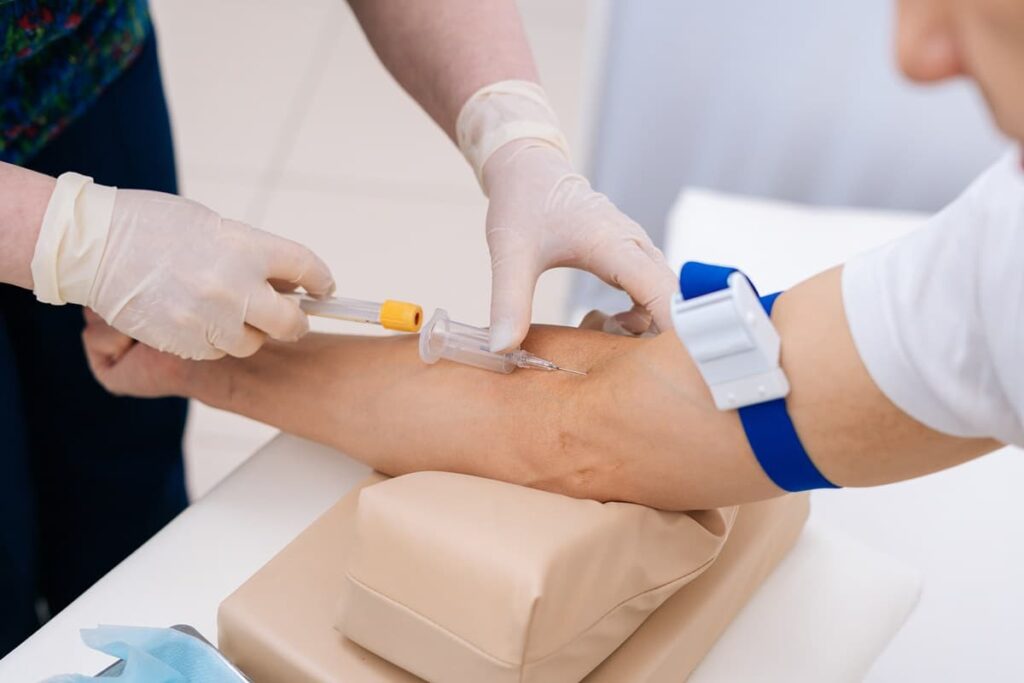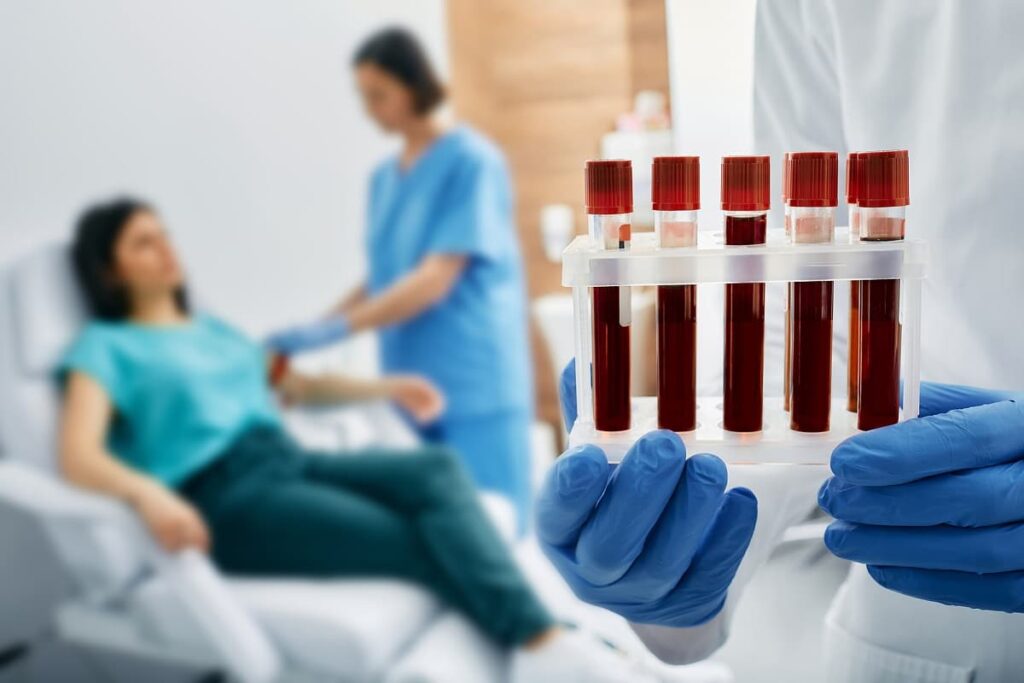8 Companies Developing Liquid Biopsy Cancer Tests
Table of contents

Cancer blood tests, or “liquid biopsies” as they are called, promise to be a huge niche in molecular diagnostics (MDx). Cowen & Co estimates that using DNA blood tests for cancer screening will be a $10 billion a year market in just 4 years. Illumina just announced that they are developing a universal blood test to identify early-stage cancers in people with no symptoms of the disease. The Illumina venture is called “Grail”, and has taken in more than $100 million in Series A financing from investors that include ARCH Venture Partners, Sutter Hill Ventures and Bezos Expeditions.
With Illumina having worked on this project for 18 months already, competing companies in this space should be worried. While over 38 companies are actively targeting this space, the below chart from Piper Jaffrey shows 6 key players that we’ll take a closer look at:
Myriad Genetics (NASDAQ:MYGN)

Those are some lofty goals, but Myriad has been making some good progress towards them. Revenues for Q3 2015 were $183 million which was down slightly from the previous quarter. Over 90,000 physicians have ordered Myriad’s tests, with over 2 million tests being performed so far.
Oncocyte (NYSEMKT:OCX)

Vermillion (NASDAQ:VRML)

Veracyte (NASDAQ:VCYT)

Foundation Medicine (NASDAQ:FMI)

Genomic Health (NASDAQ:GHDX)
Since their market debut in 2005, this $1 billion market cap company has returned +166% compared to a NASDAQ return of +113% over the same time frame. Similar to Foundation Medicine, Genomic Health has made a strong business of detecting cancer in tissues obtained from biopsies using their Oncotype DX test suite which brought in revenues of $275 million in 2014. In January of 2015, the Company announced their intention to release a liquid biopsy test in 2016 which they would price much lower than their Oncotype DX test which is priced at around $4,500.
Biocept (NASDAQ:BIOC)

Guardant (Private)
While not mentioned in the above chart from Piper Jaffrey, Guardant is a company we wrote about in March 2014 which is developing the GUARDANT360, a test that looks for tumor DNA which is shed into the bloodstream for almost every type of cancer. Just last week, Guardant closed a massive funding round of $100 million, the same amount of money put forward by Illumina to launch Grail. Guardant360 is currently being used by 20,000 patients with cancer per year at a price point of $5,400.
Conclusion
Want to invest in the “liquid biopsy” space? The best way is to buy a diversified portfolio of these stocks, but how can you avoid the large number of transaction fees? The best way to invest is to sign up to Motif Investing. For $9.95 a trade, you can create your own basket with up to 30 stocks. Take a look at the sample motif we just created using 6 of the above publicly traded “liquid biopsy” stocks:
Motif is an excellent platform which we reviewed in a previous article, and we use it to invest in baskets of stocks across all kinds of disruptive technology themes.
Sign up to our newsletter to get more of our great research delivered straight to your inbox!
Nanalyze Weekly includes useful insights written by our team of underpaid MBAs, research on new disruptive technology stocks flying under the radar, and summaries of our recent research. Always 100% free.


















Nice article and certainly a space that is well worth watching. There is a bit more context to the Grail announcement by ILMN that is worth considering. I wrote a short blog on it which can be found here http://seekingalpha.com/instablog/400846-marty-chilberg/4709746-illumina-cancer-diagnosis-to-survivor-is-the-grail
Investors in this segment should be aware that there are both short term and longer term market opportunities. The Grail mission is to prove that we can save money and lives by introducing a blood screen similar to a blood chemistry test that most take at an annual physical. This screen will hopefully prove successful not only in diagnosing cancer but doing so a increasingly earlier stages. The ability to find cancer in a “local” stage or before it has spread elsewhere dramatically improve the life expectancy of the patient. The costs to be incurred by Grail will likely be upwards of $1 billion over time as it will take perhaps 30,000 individuals being tested annually or biannually for several years to prove the value of repetitive screening. Not only do they have to prove that plasma screening will diagnose cancer effectively, but the need to show that they can catch it far earlier with recurring screens. The former provides the reason for those with ability to pay for a diagnostic test. The later is what makes the test accessible to all by providing coverage and reimbursement. Illumina has said that this is the sole objective of Grail, meaning they do not intend to compete in other market segments.
Most of the 3-4 dozen companies that have announced plans for liquid biopsy are looking at more targeted segments. Once cancer is diagnosed through an invasive biopsy, the ongoing tracking (treatment monitoring) is quite challenging. Many patients are unable to survive multiple invasive biopsies and given life expectancies in later stages, they don’t have time to waste. Using a blood test to determine the impact of a particular treatment regimen is very likely to be one of the earliest market opportunities. Particularly in areas such as lung cancer where the alternatives of CT Scans are just not very effective. Similarly colon cancer is viewed as an early market for entry. The cost and aversion to colonoscopies is pretty significant and similar to the early adoption of NIPT in high risk pregnancies it will be quickly endorsed as a more effective alternative that is cost effective for the 50+ age group. There are several companies current marketing or developing tests in this segment. They should not have to worry at all about ILMN.
Companion diagnostics, personalized clinical trials, treatment monitoring and recurrence monitoring are segments that are expected to see earlier traction. Early detection/diagnosis is indeed the long term objective but it will likely take several years before that is ready to be offered commercially.
Look forward to seeing more articles here on the topic.
Great analysis as always Marty. So Illumina wants to be the widely adopted broad test and all the other players right now will pursue niche detection applications. It’s interesting to think how pervasive early detection tests would be if we knew that the survival rates where in the 90 percent range for all cancers if they were detected early. Everyone would be taking prevention tests. This has some interesting implications for human lifespan too.
Agreed. Lots of implications. Another issue to watch for future development is the PPV for Grail. Consider the PPV with respect to low risk NIPT which drops dramatically from high risk. The NPV is still very high so in reality the test still does what it is intended to do which is to eliminate the need for NIPT in 97% or so pregnancies. With a negative predictive value of 99% the test does what it was designed to do which is to comfort moms who have a negative test result that there is no reason to undergo an invasive procedure because the probability is very high that negative does mean a negative. However the positive predictive value drops to a coin flip at about 50% when the mother is 25 years old and low risk.
If this PPV is similar for early diagnostics, Grail will have a VERY hard time proving the cost effectiveness of the test. They need to not only prove they can catch cancer early enough to signficantly improve life expectancy, but also to show that a positive screen is more probable than 50%. If not they would encourage too many false negative screens to undergo expensive invasive procedures needlessly.
Personally I think the science will improve enough to move the PPV calculation but it’s not a slam dunk.
This story is the biggest crock of crap money can buy, I now know who to watch to go the opportunity direction.
BIOC is the big winner with Blue Cross Blue Shield in all states jumping on board, Dont allow a Dr cut on you!
If BIOC is the big winner here, then why have they lost 90% of share price value in the past 5 years? We’ll take a look, but your comment is not giving us much assurance about what we’ll find there.